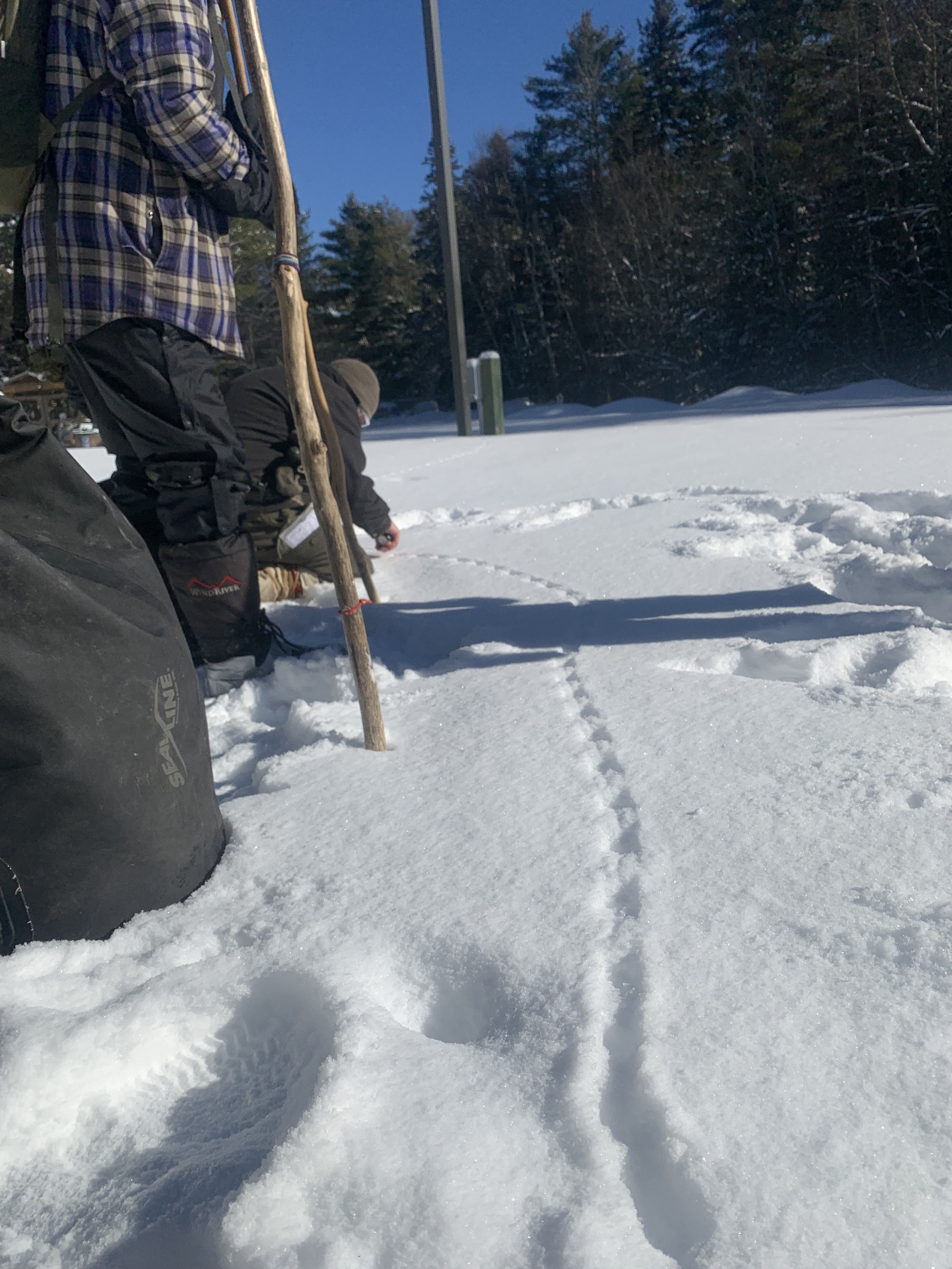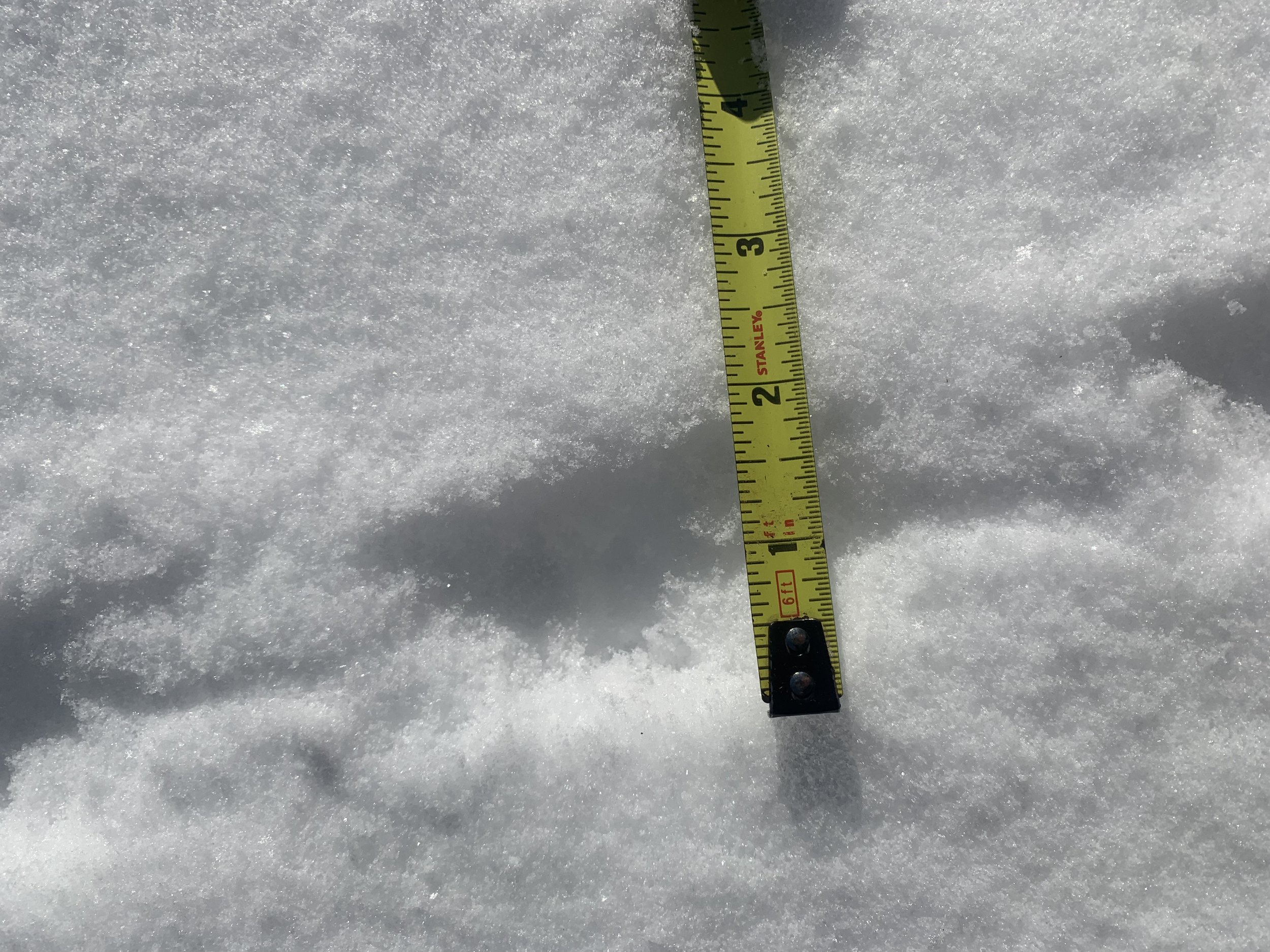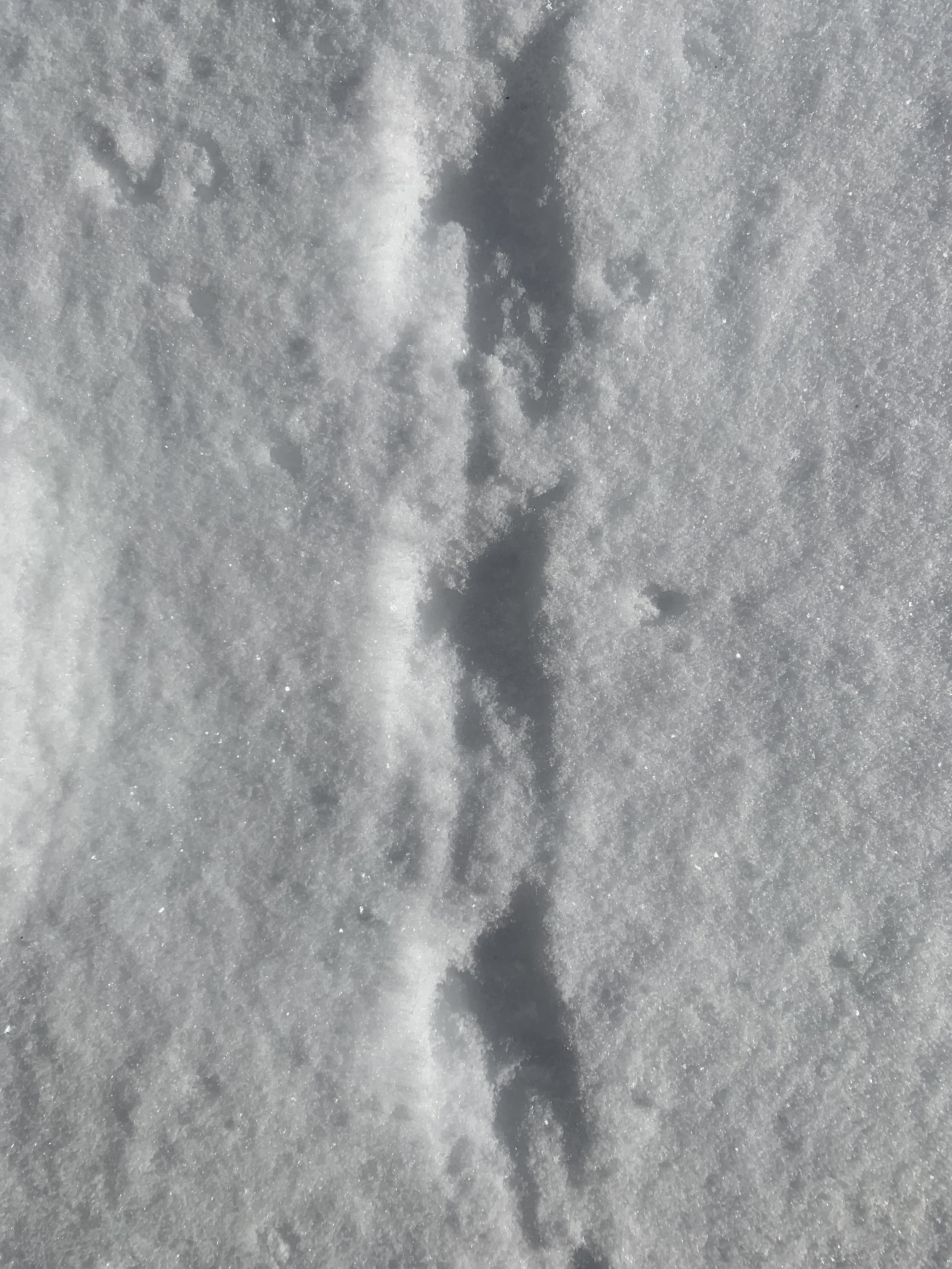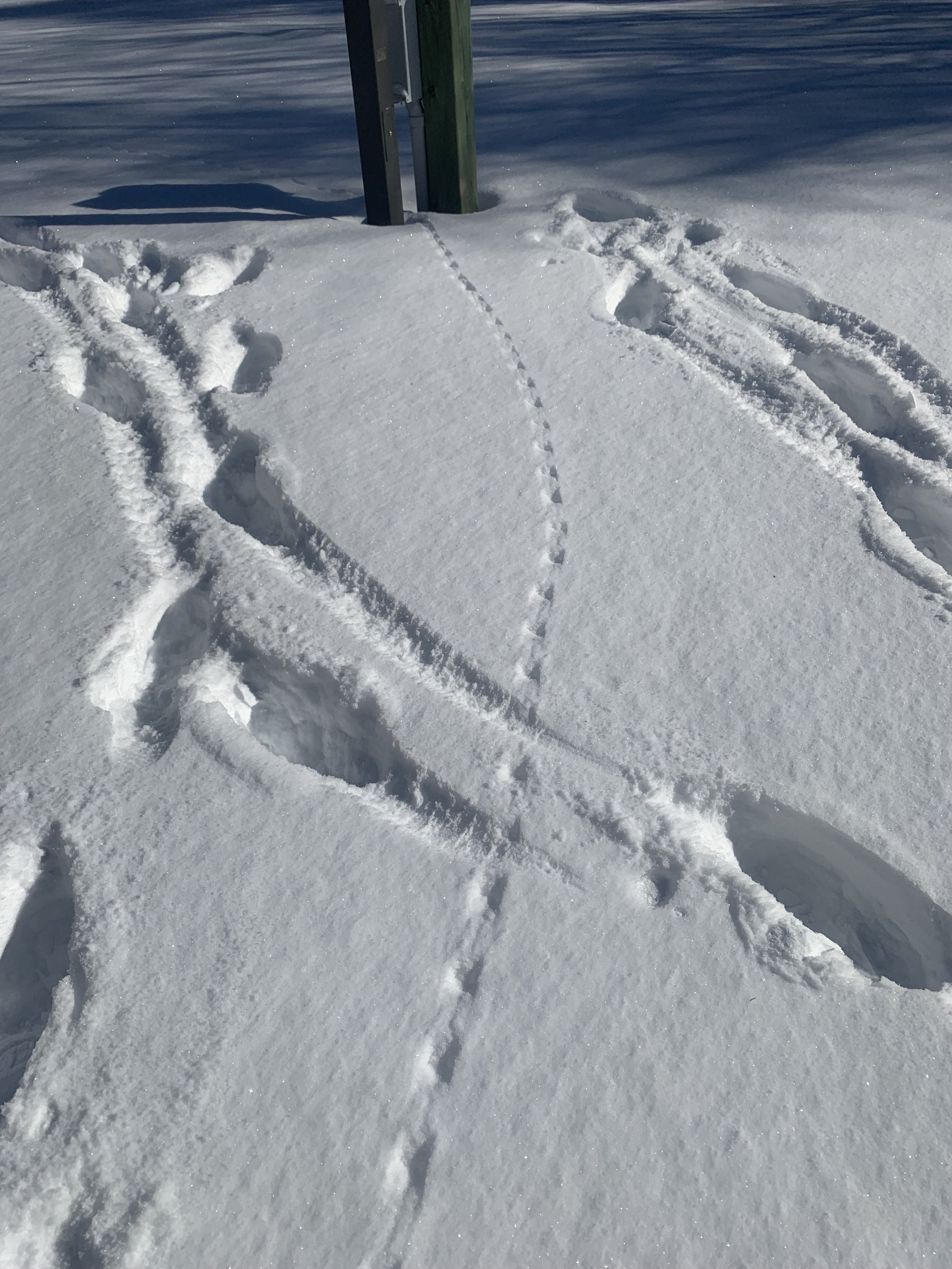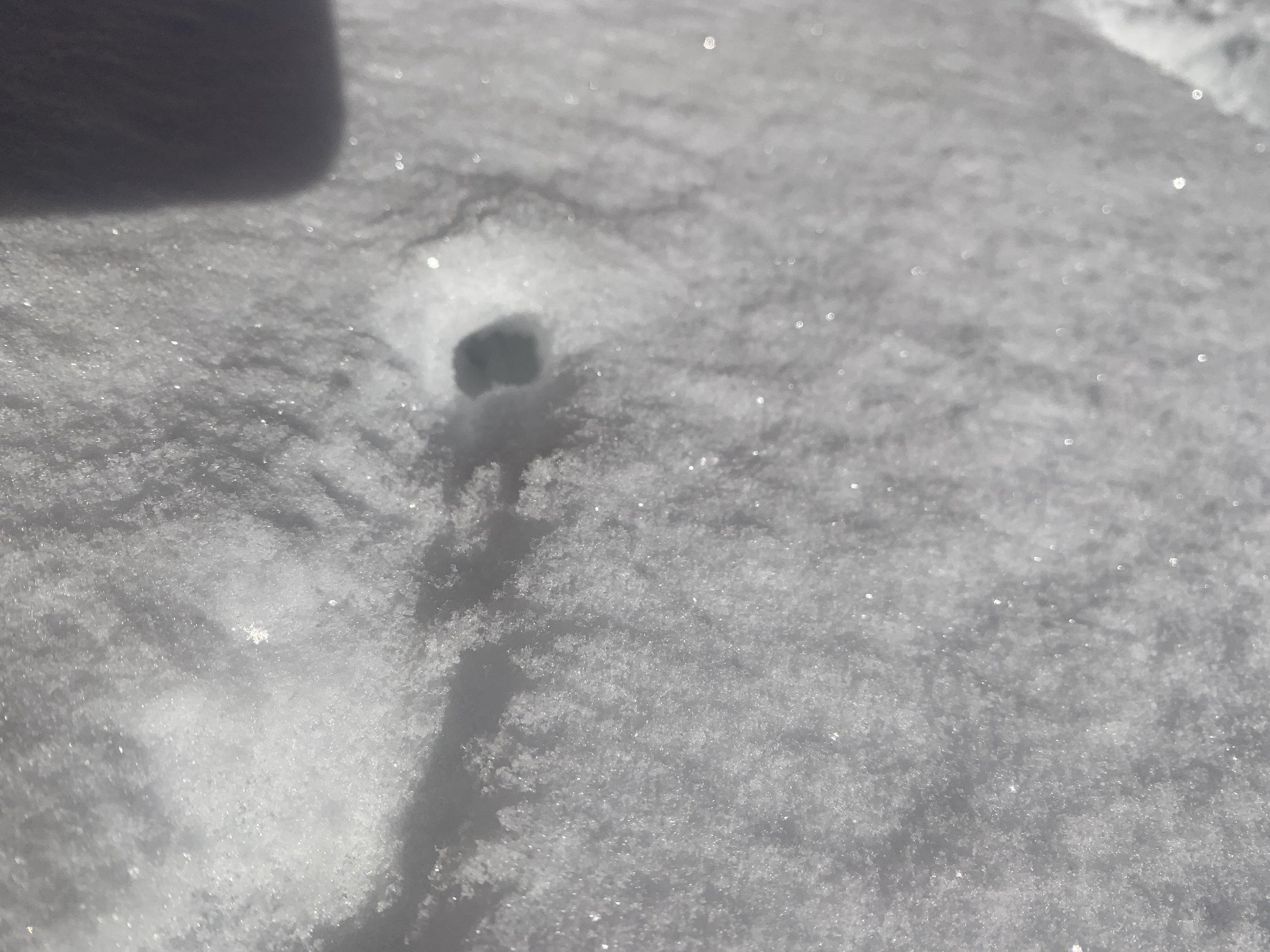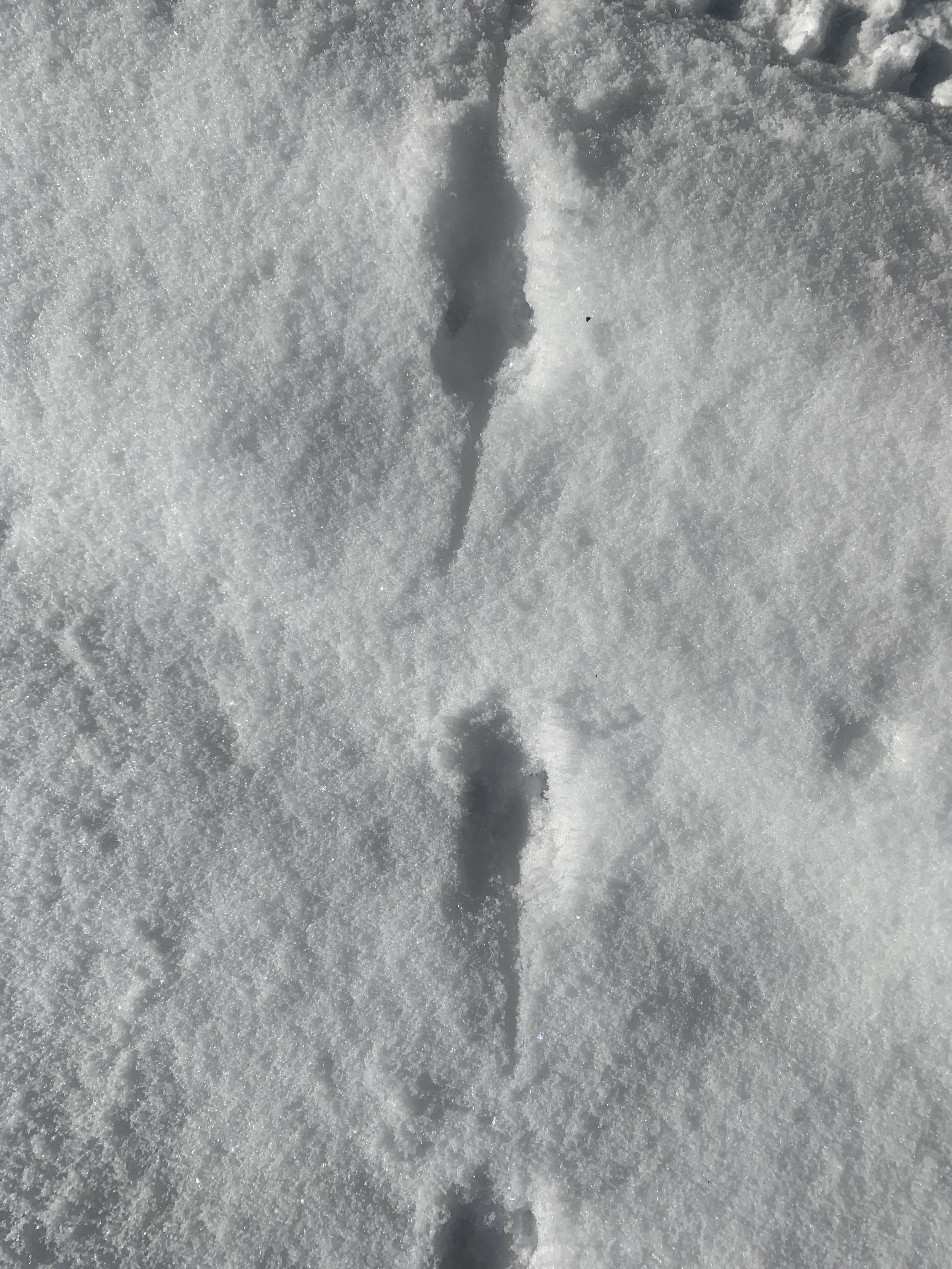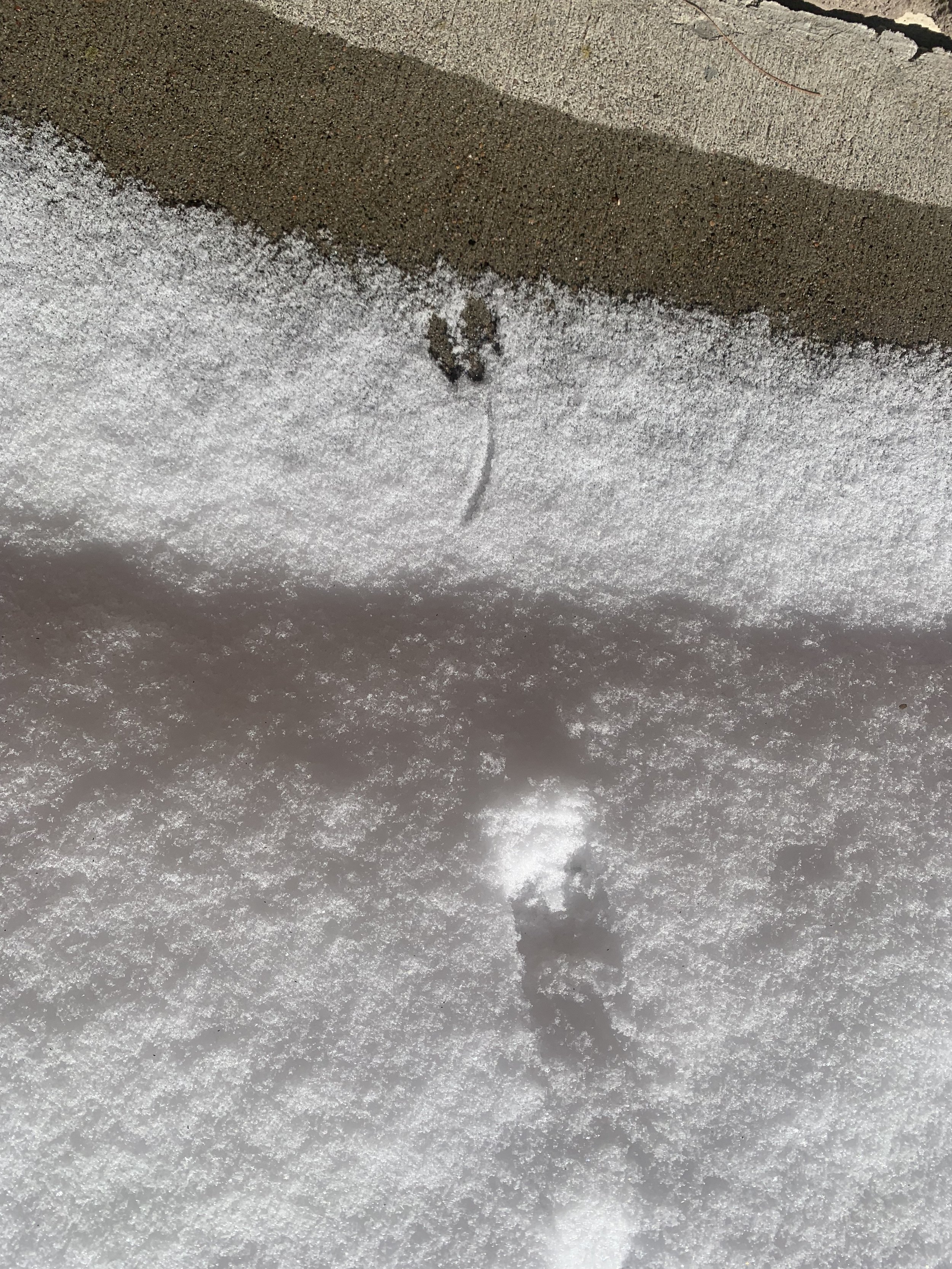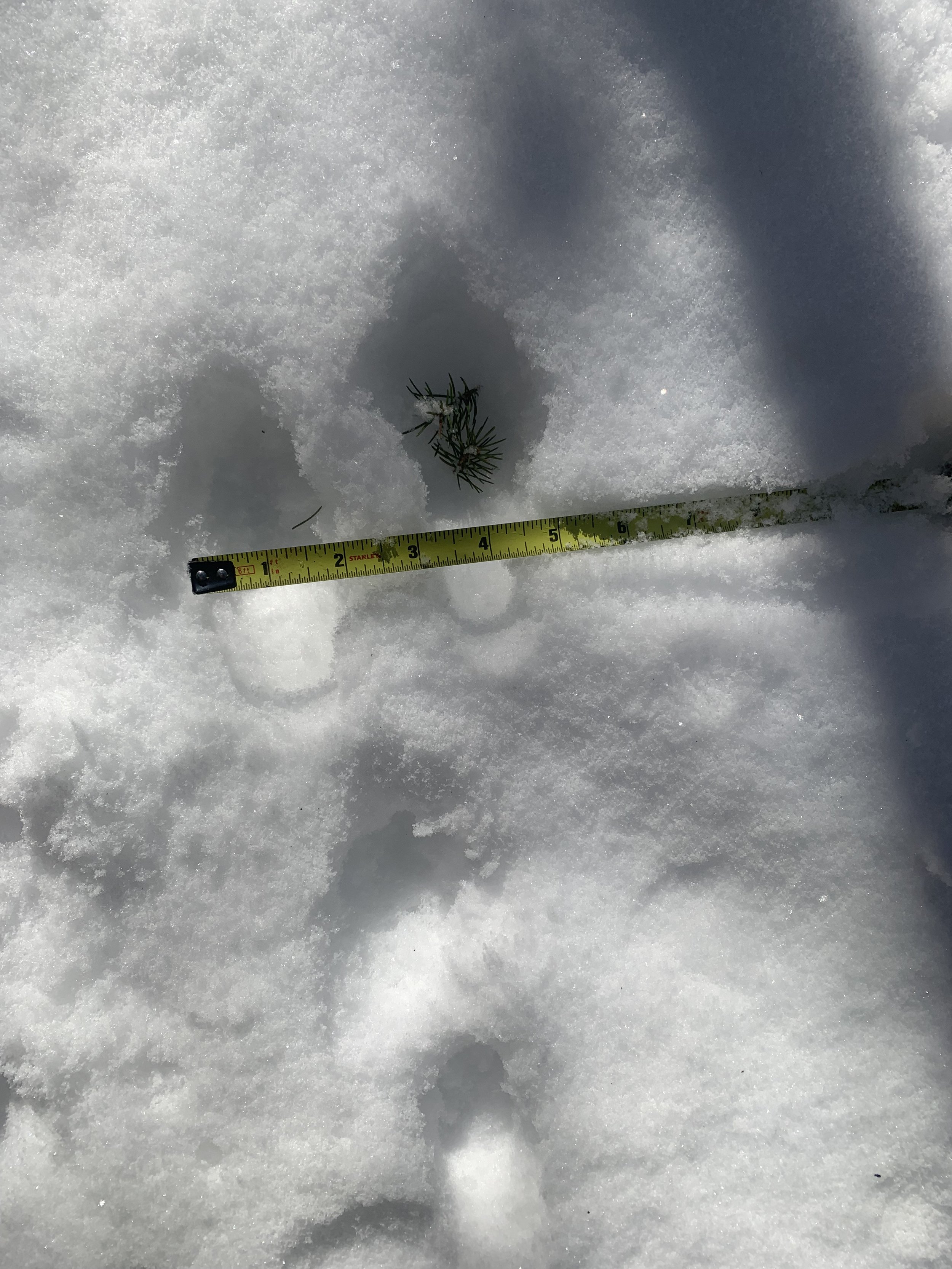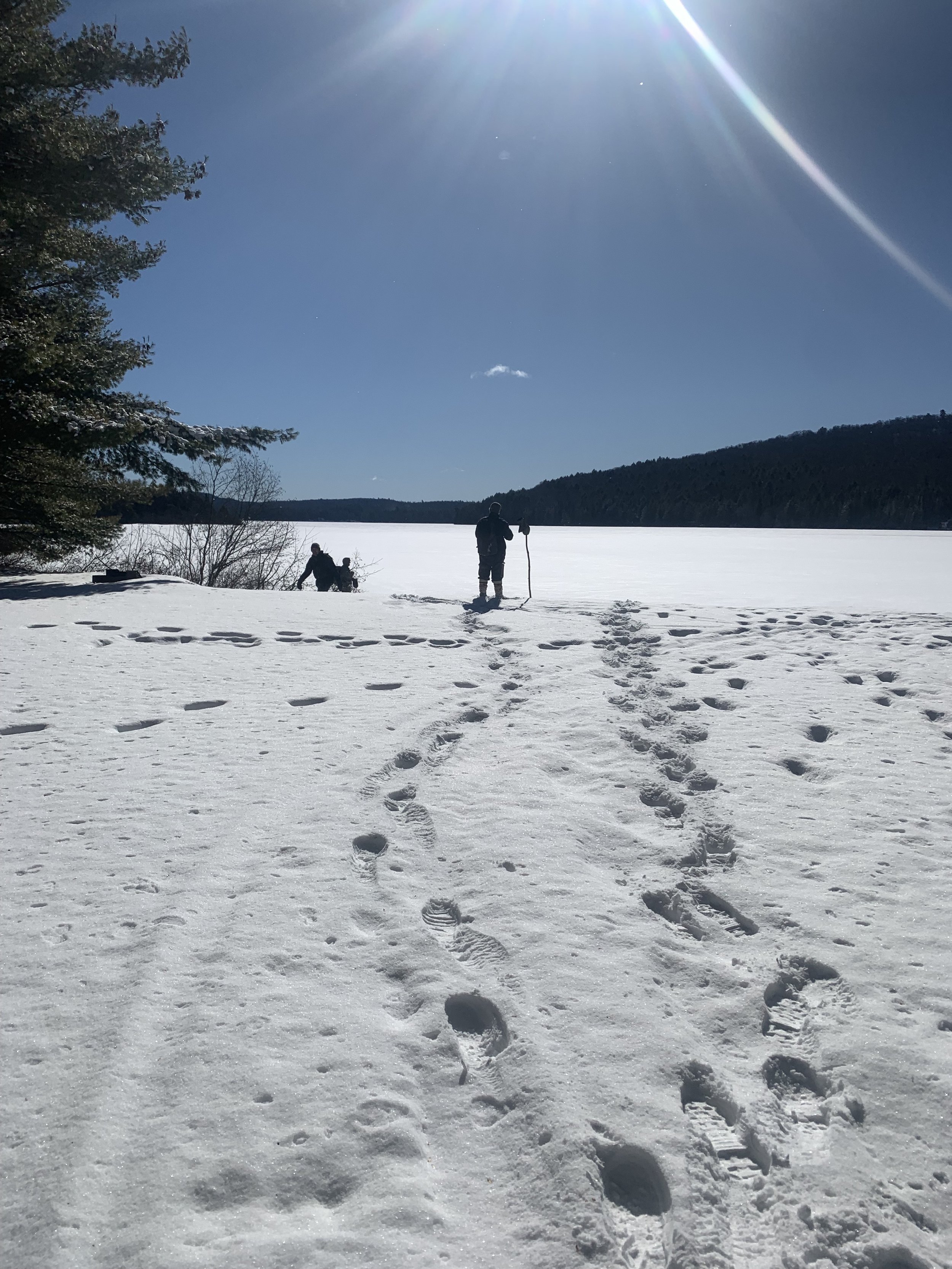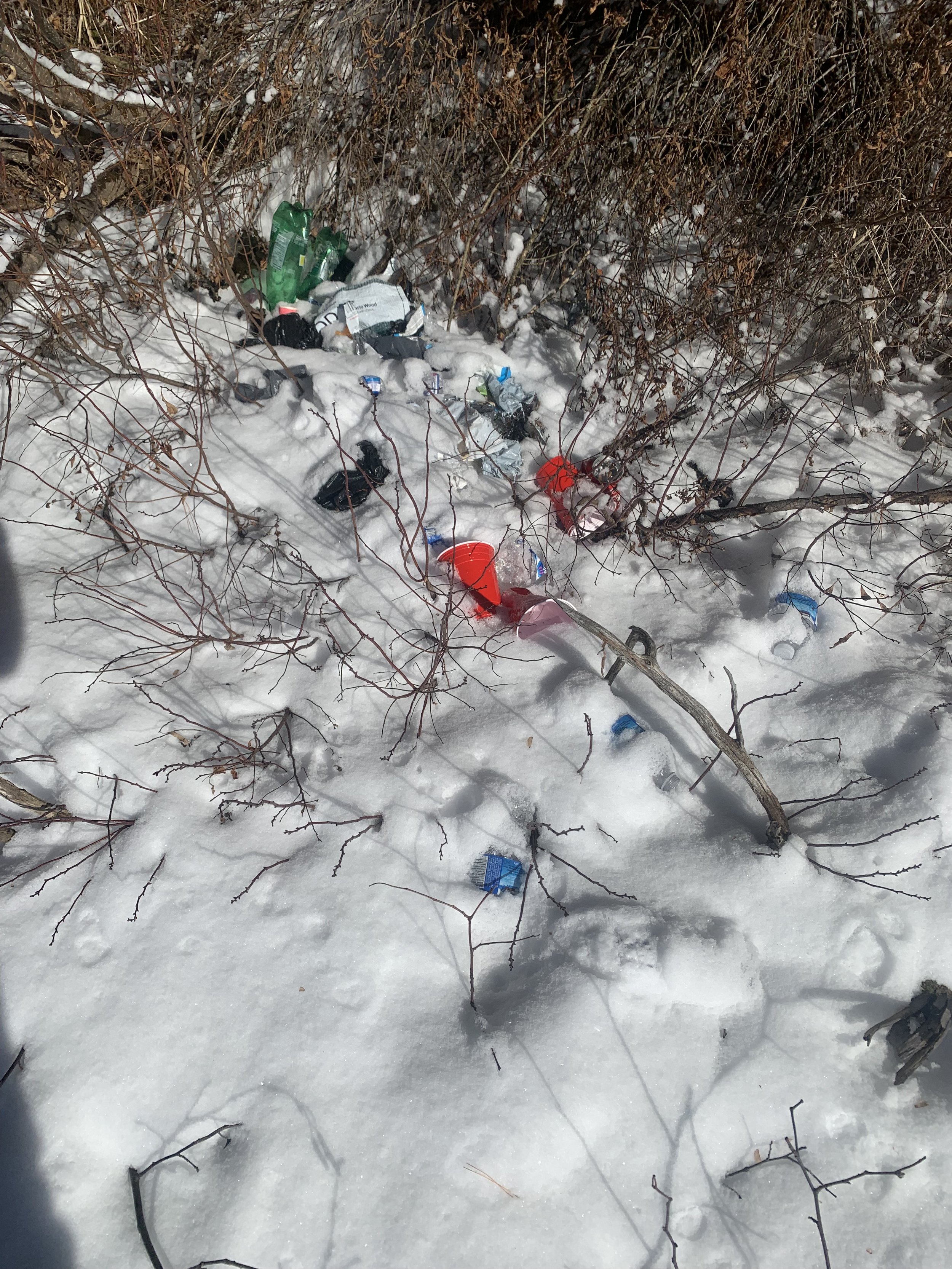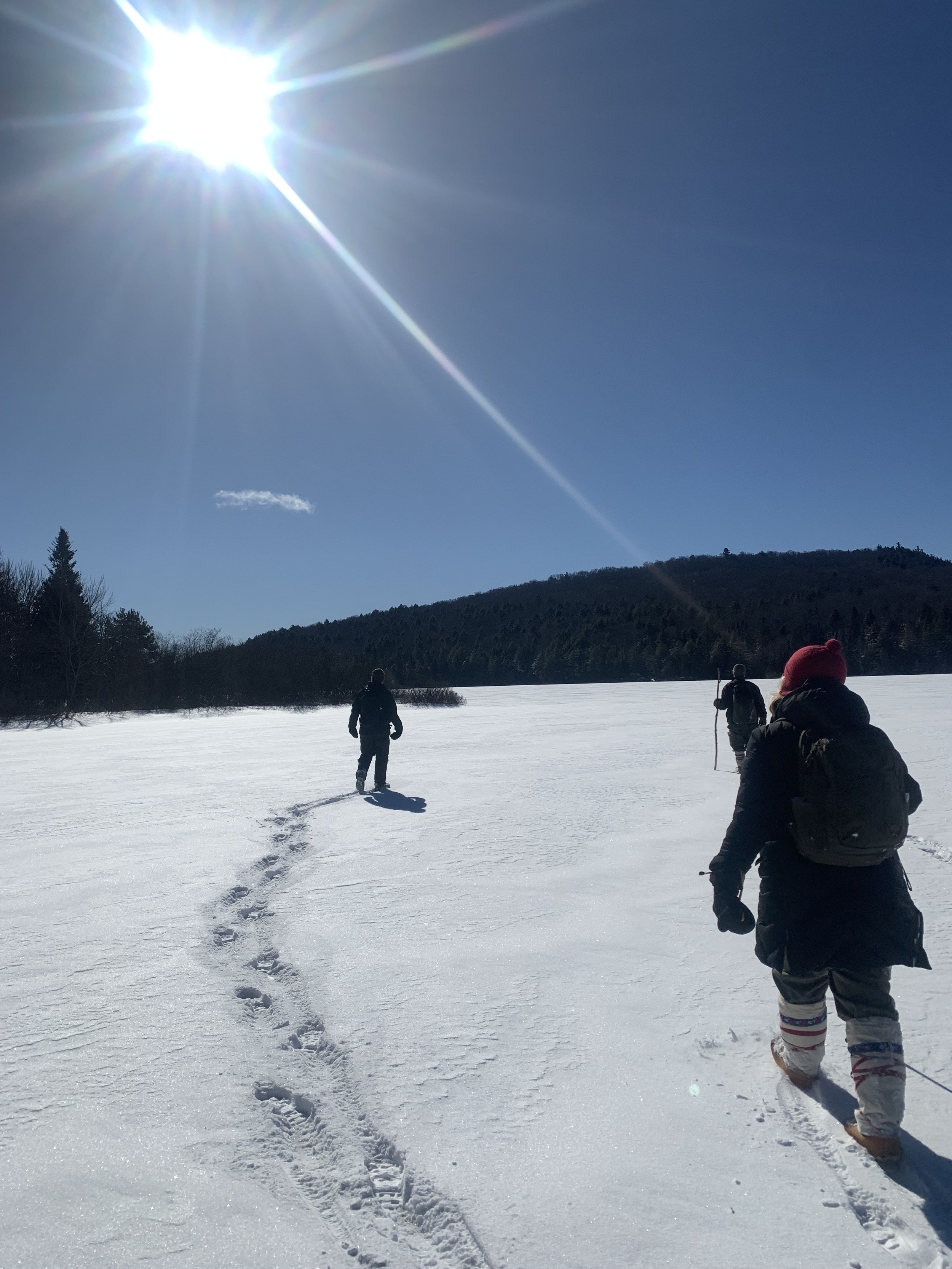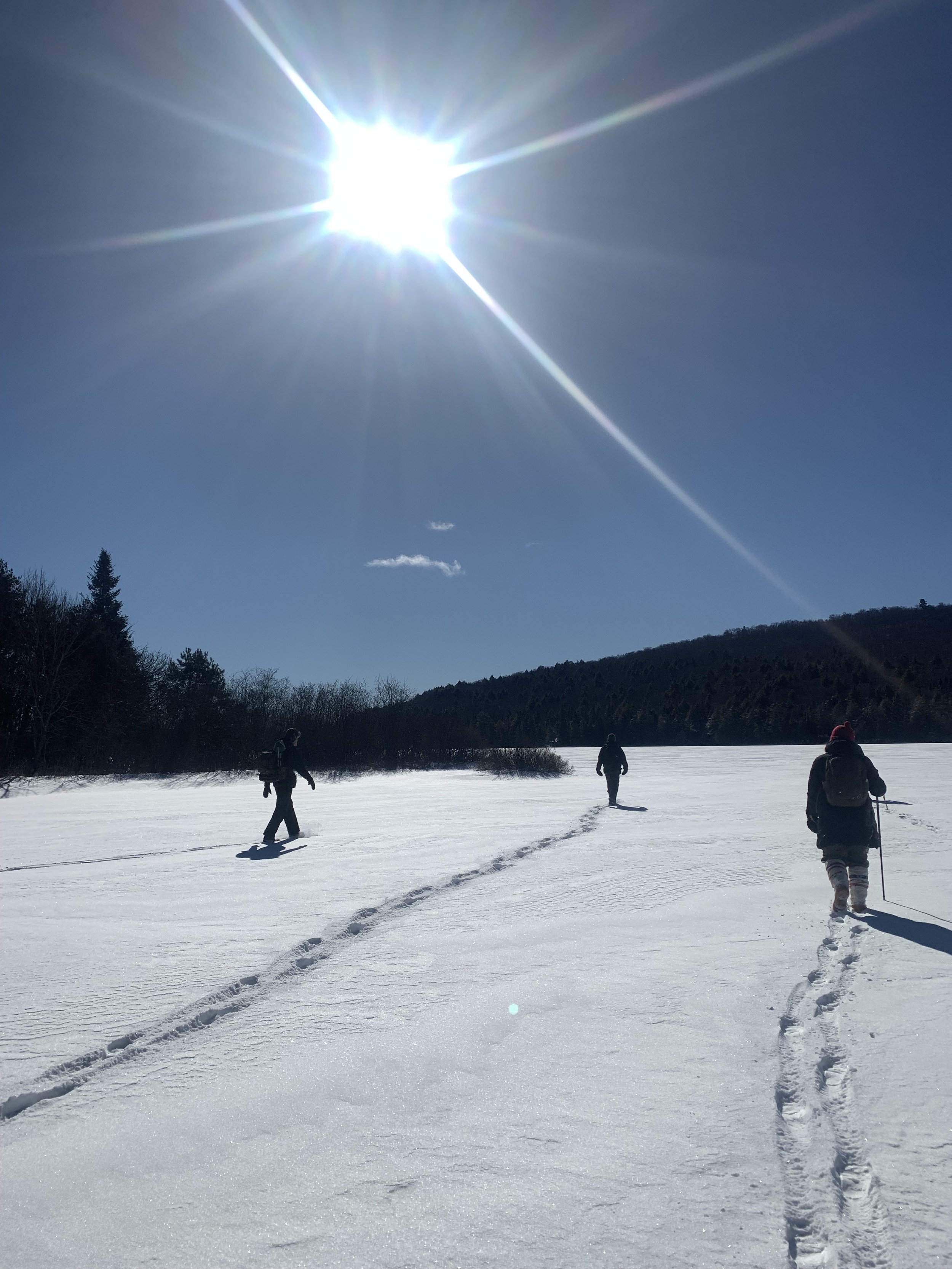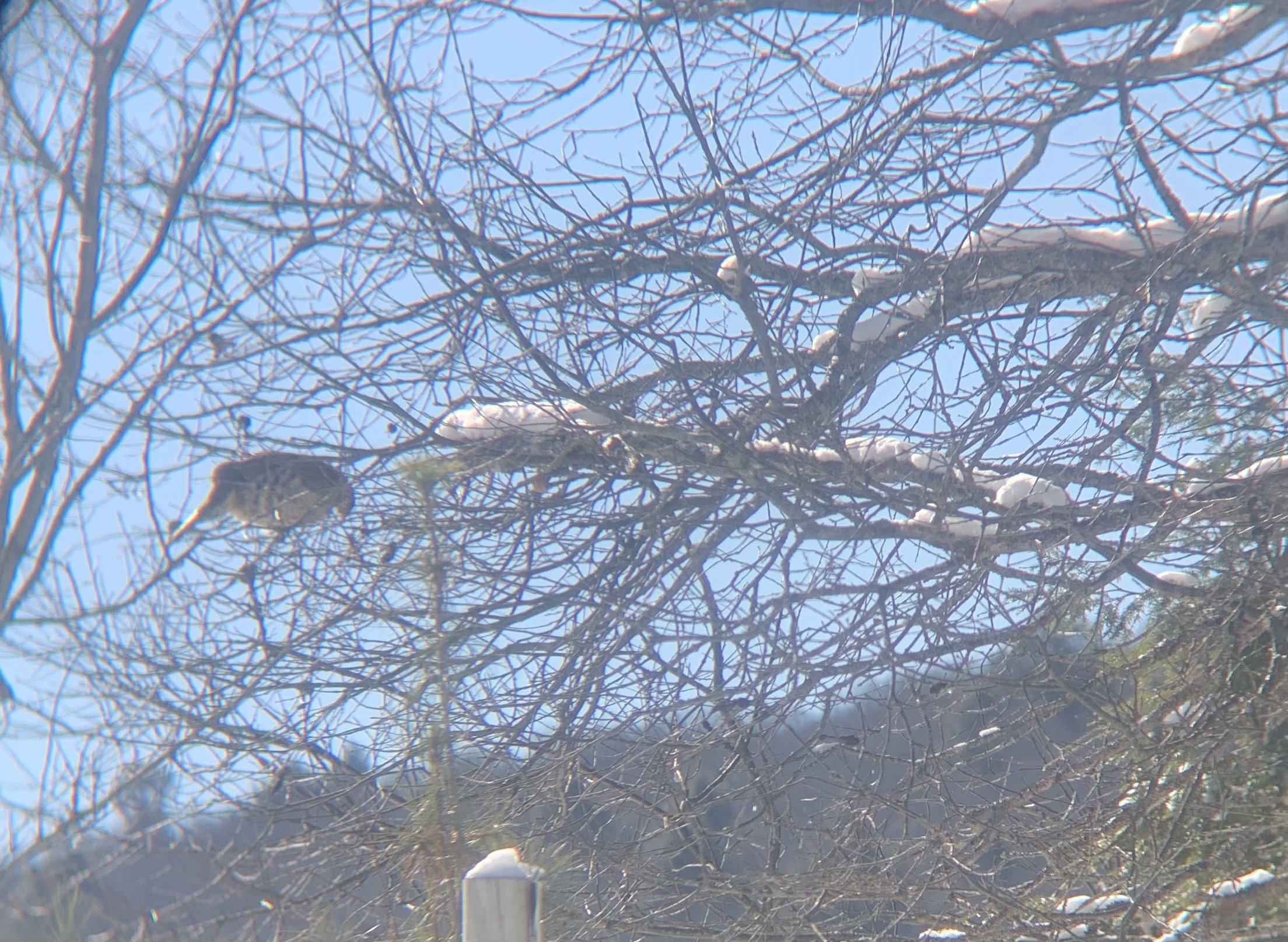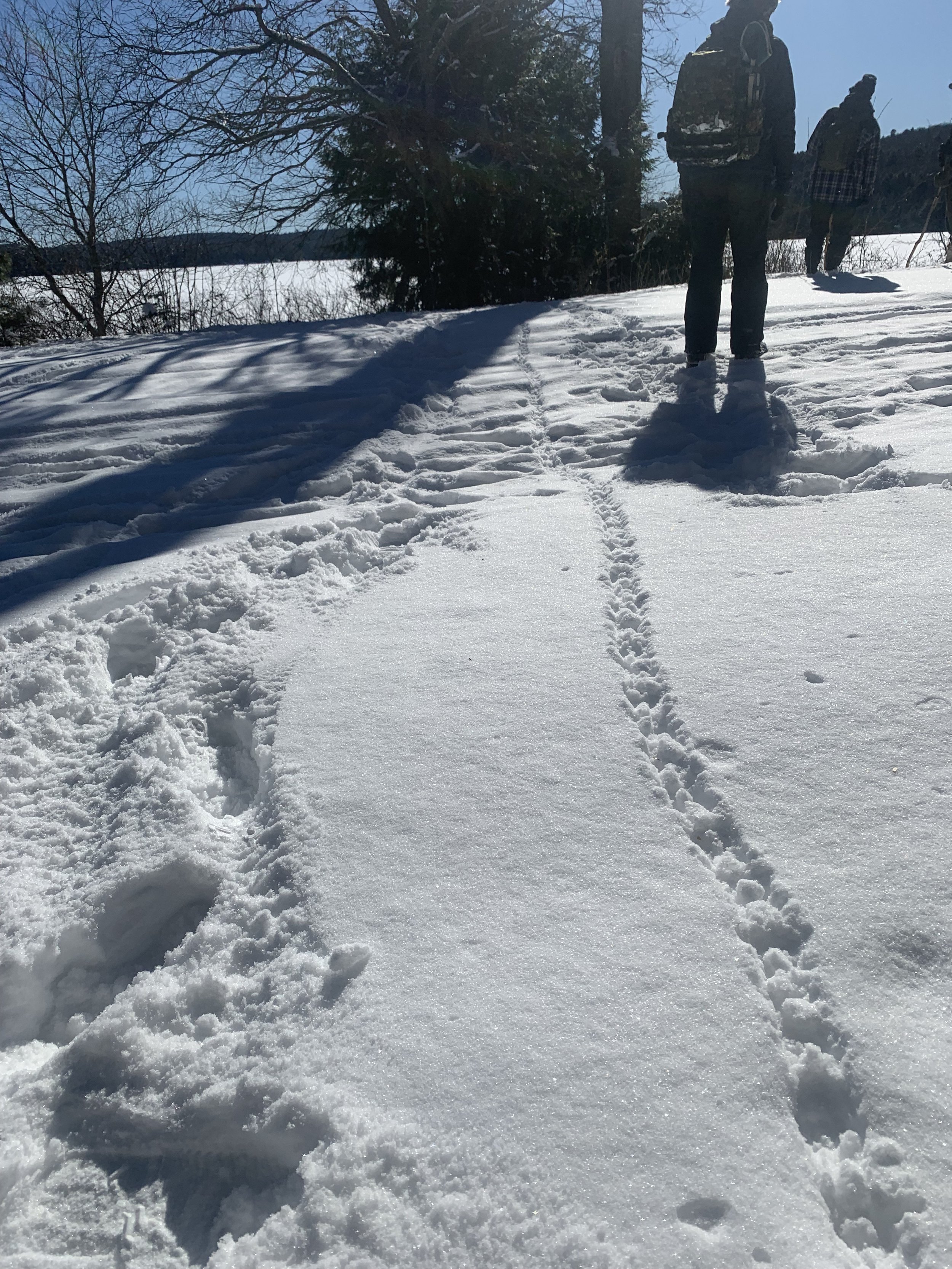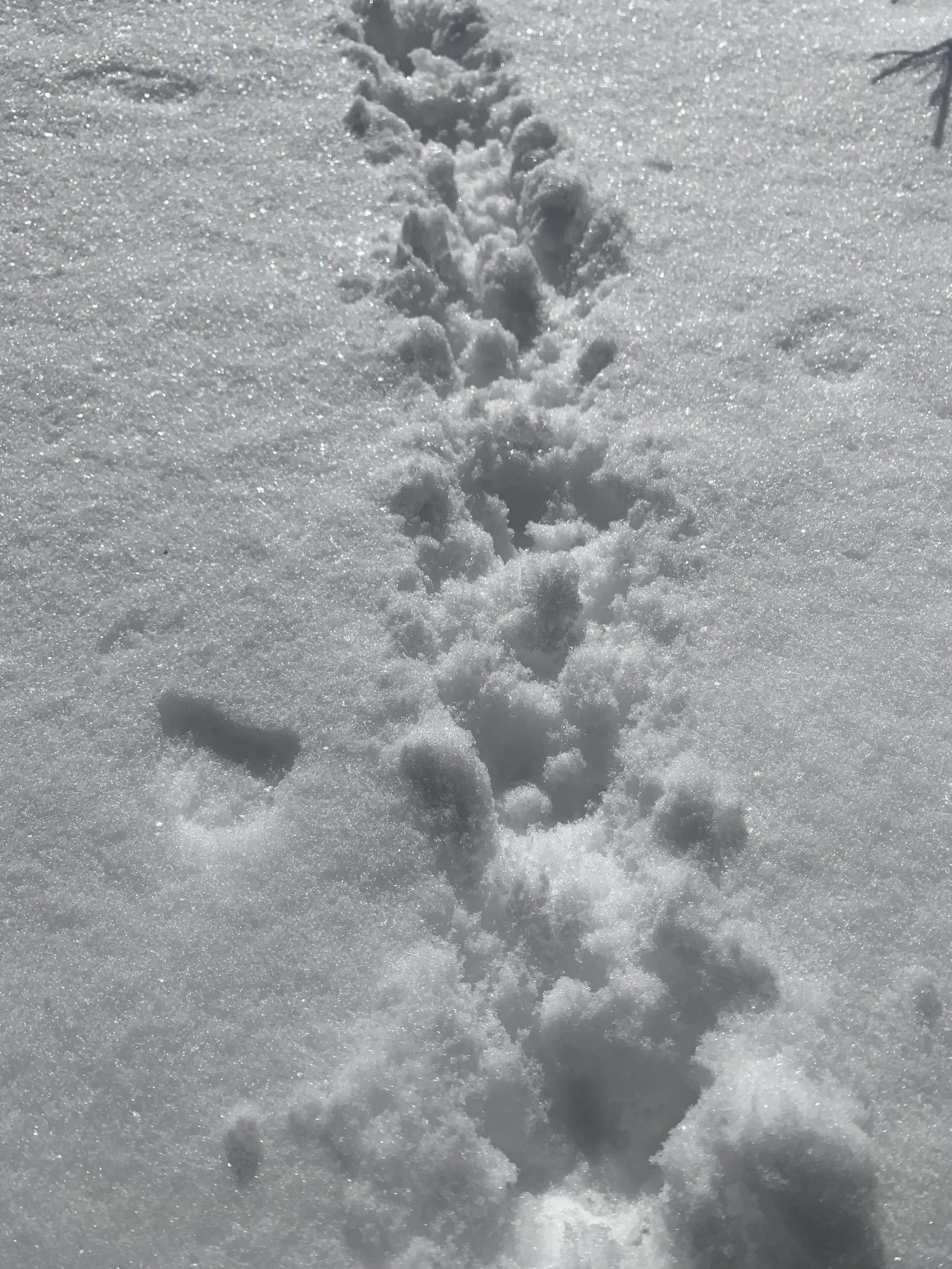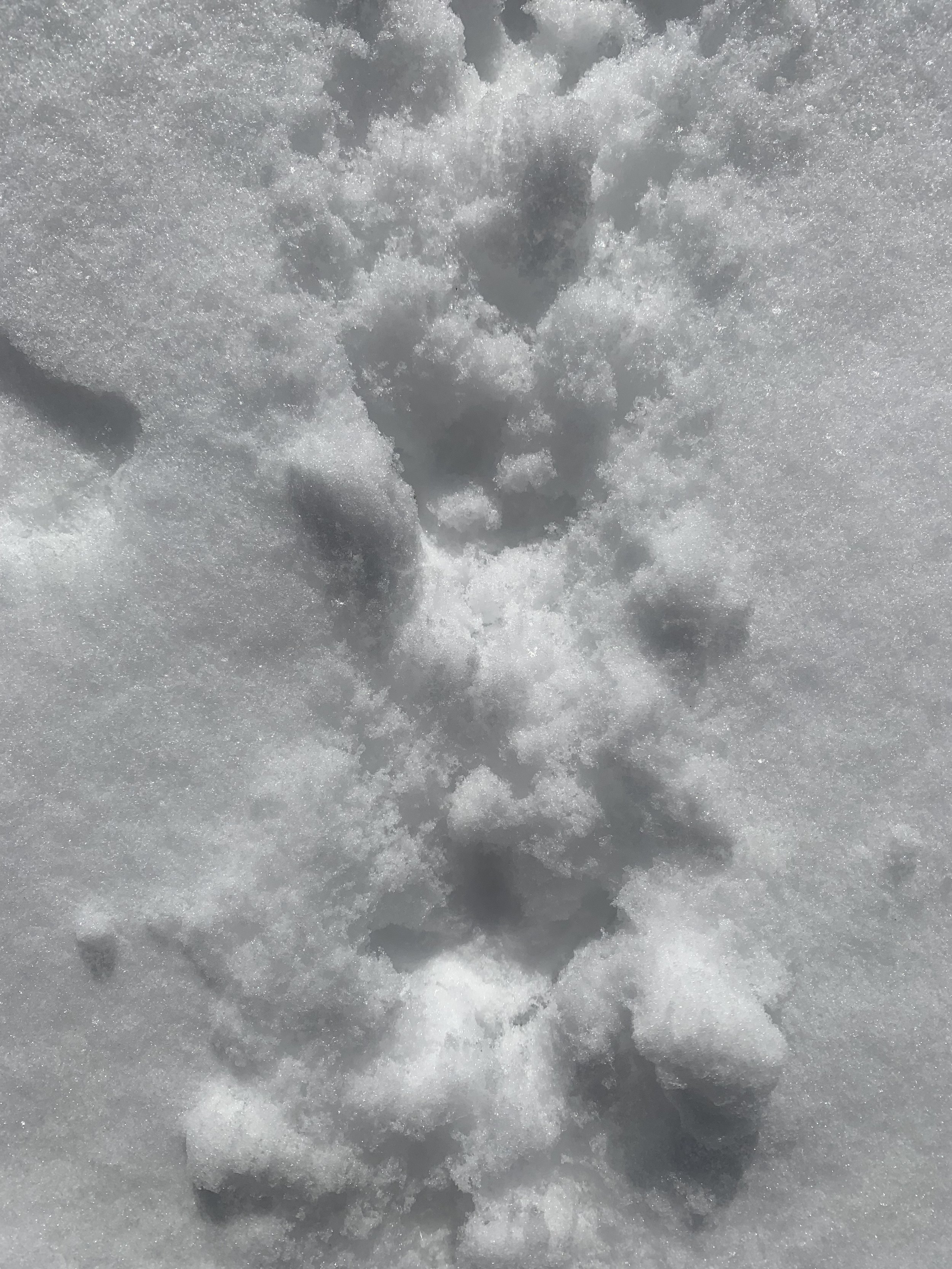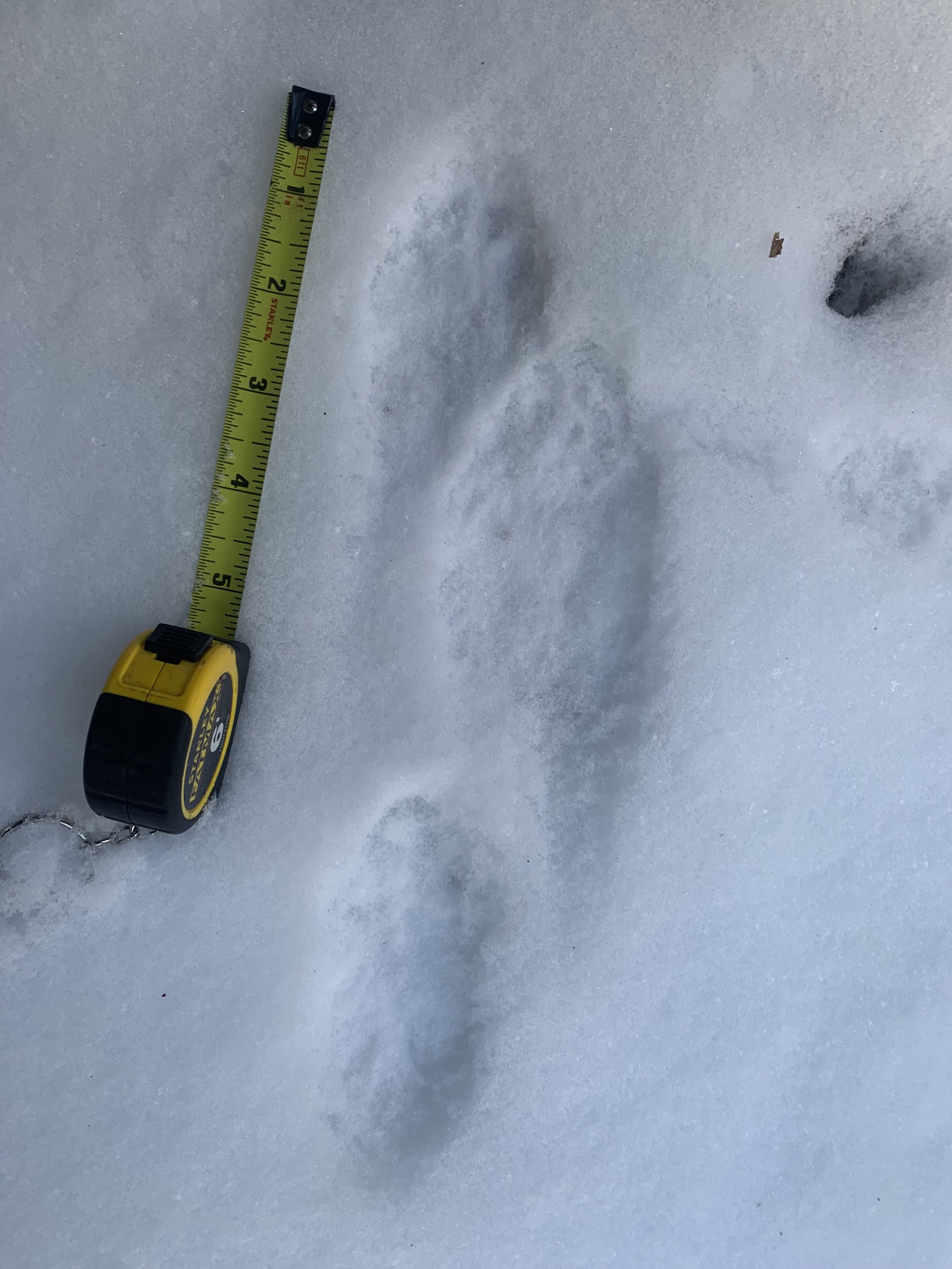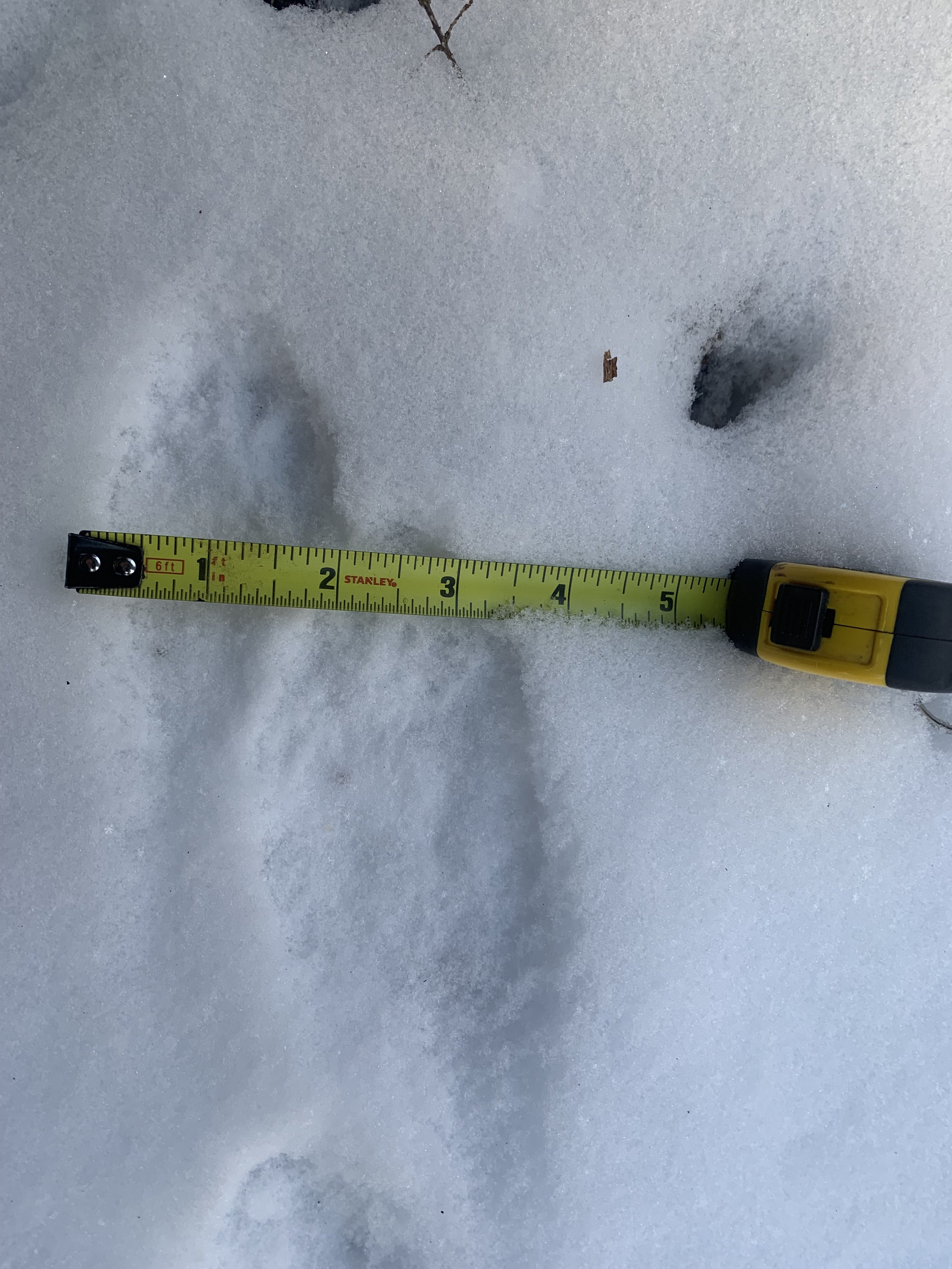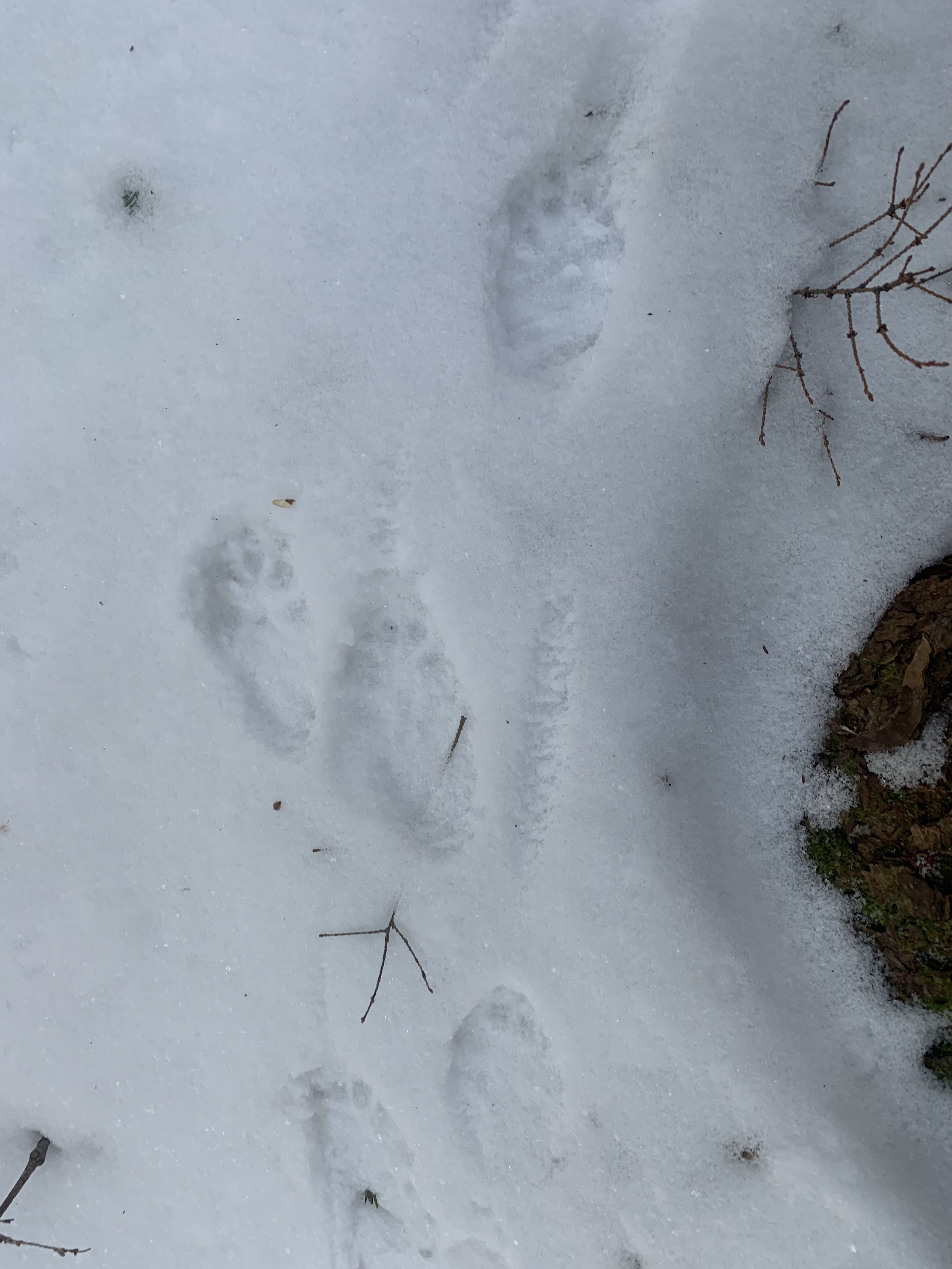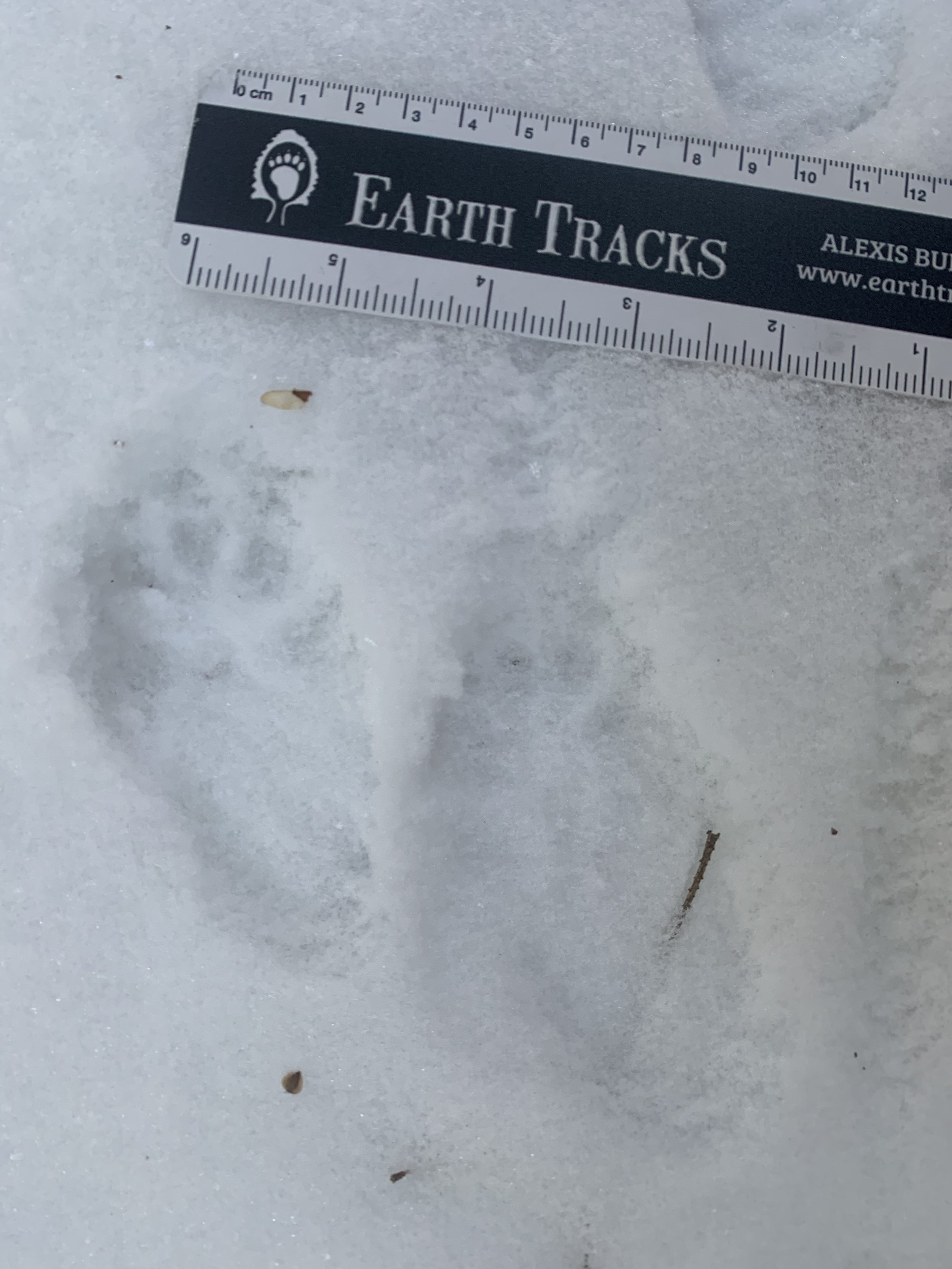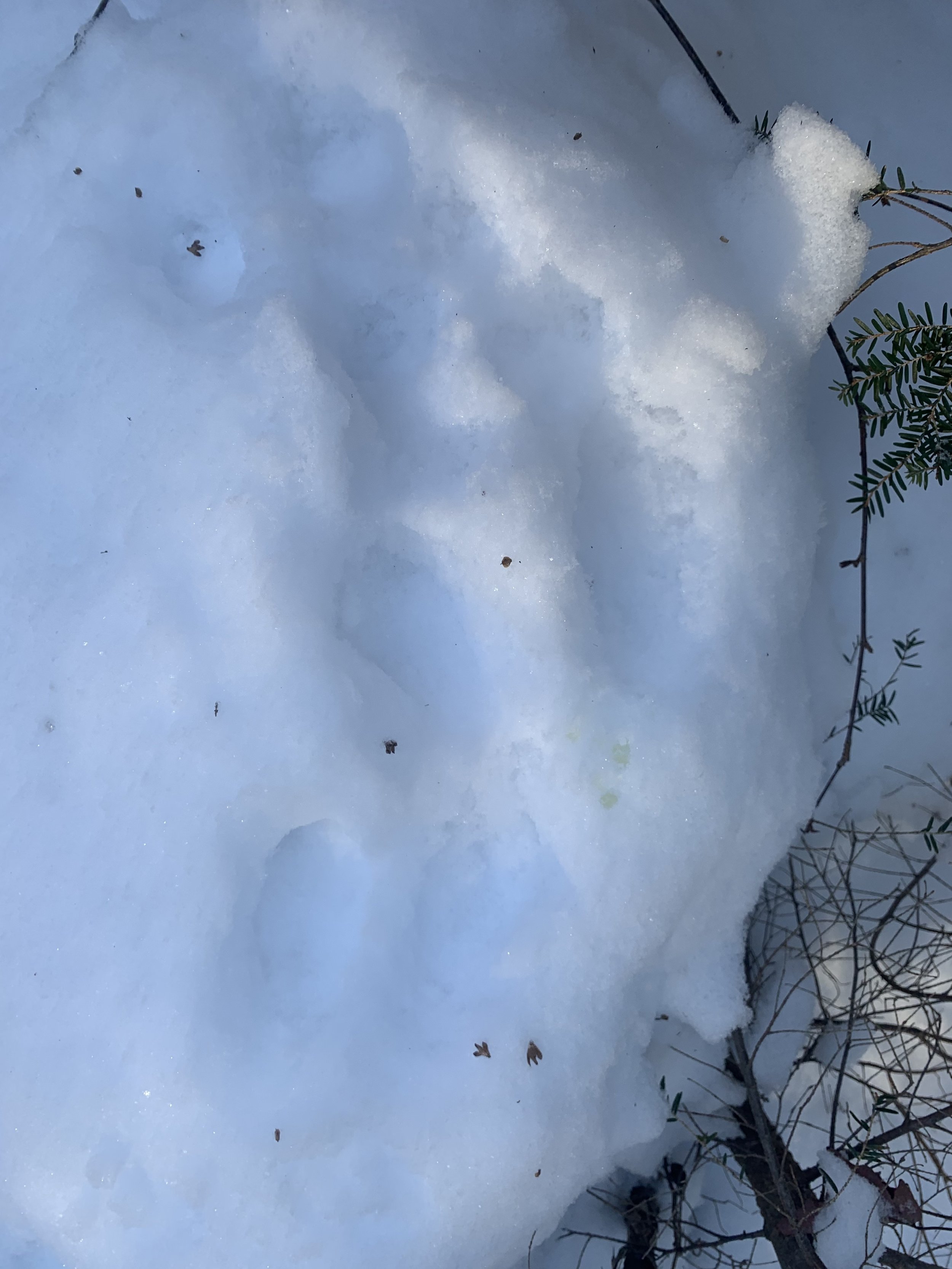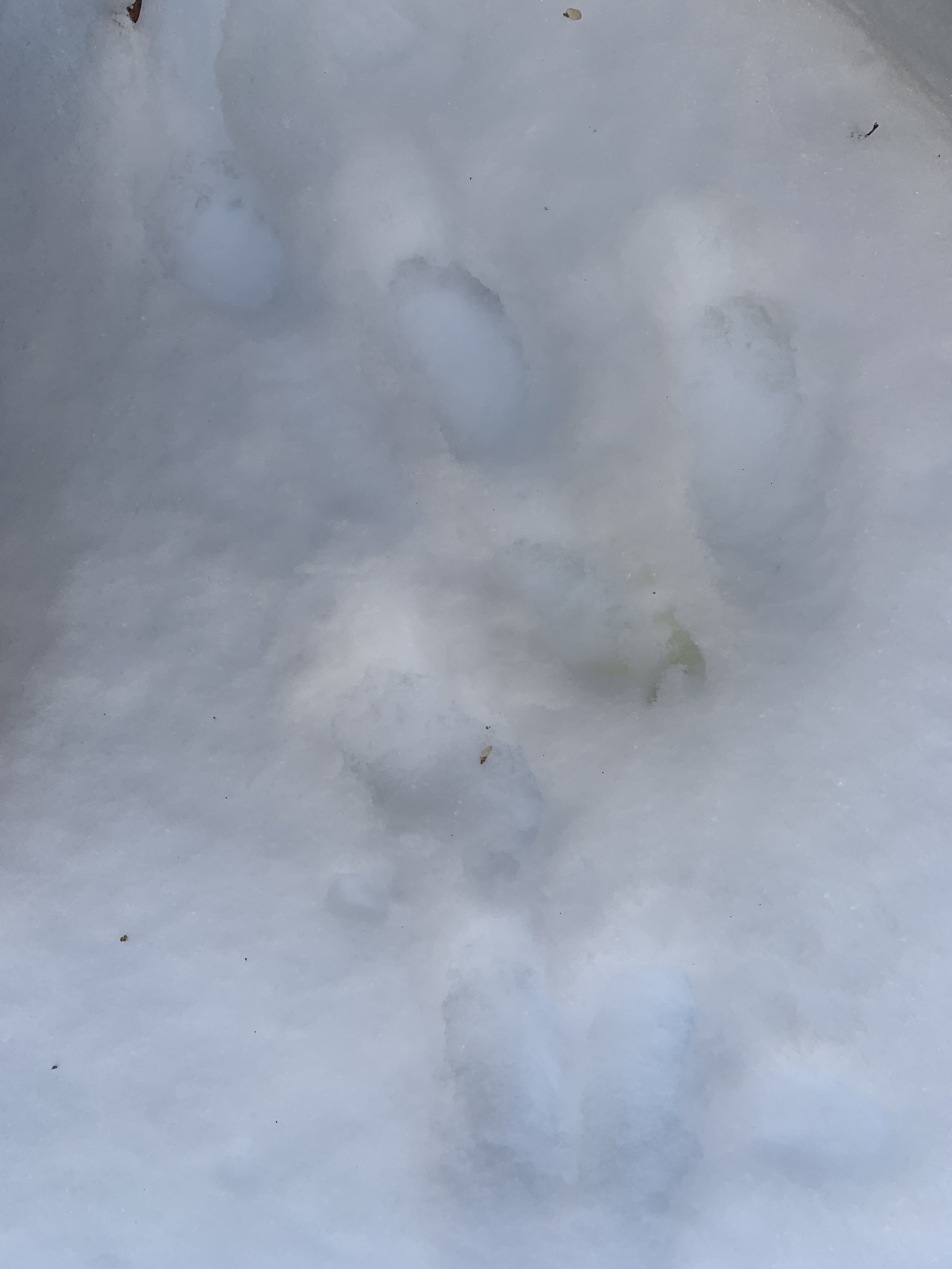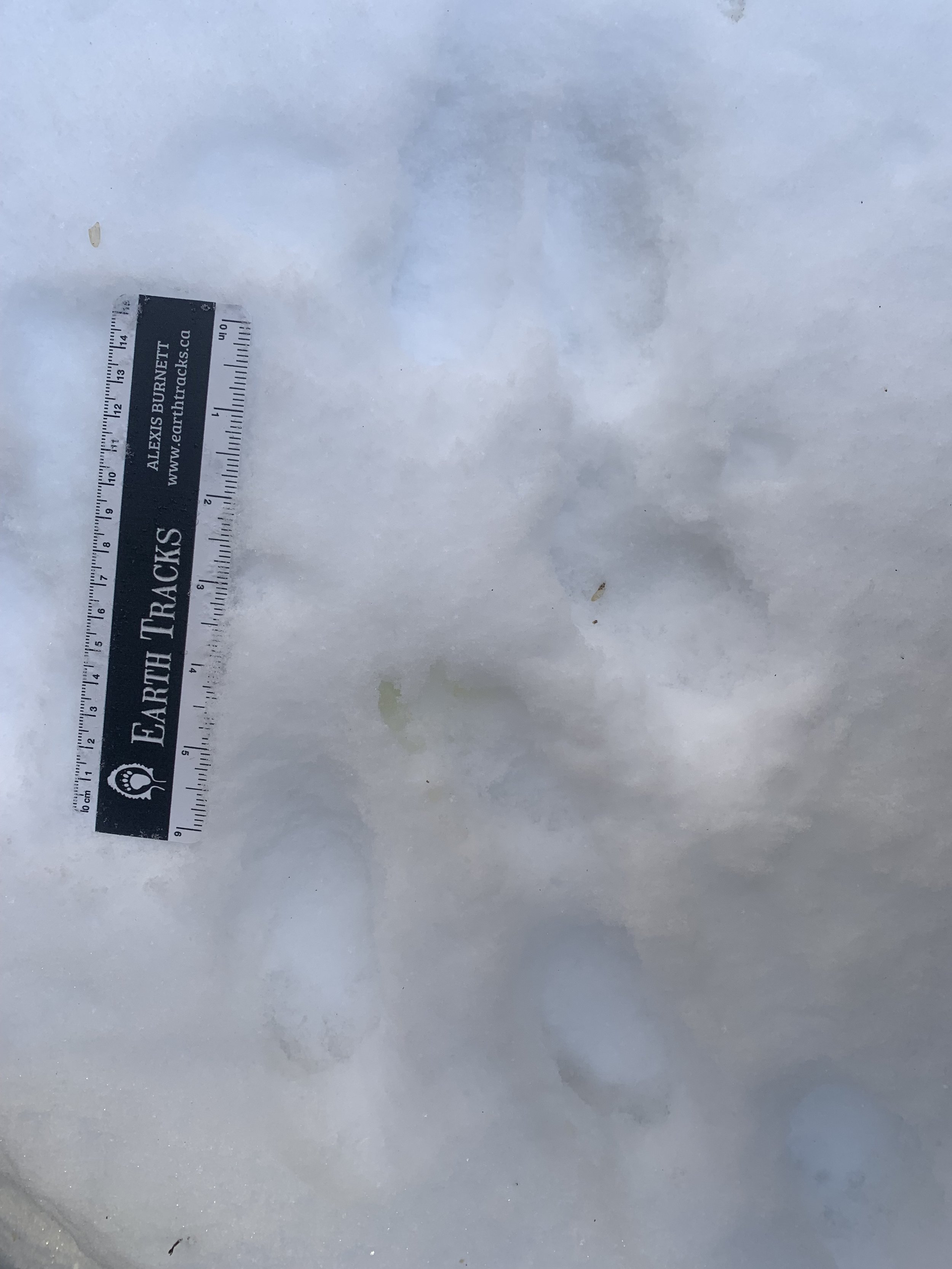Day 3: Algonquin Park
Mouse, snowshoe hare, walking over the frozen lake, grouse, and tracking a pair of Pine Martens
Wednesday, February 17, 2024,
Day 3:
We would spend the day around and on Rock Lake, a beautiful blue-sky-day!
Rock lake parking lot and office.
The very first track that we found was only a few steps from the vehicles, all around the Rock lake office.
A fresh morning trail of a mouse, with Alister and Alexis taking a measurement.
The small and mighty mouse
A creature as small as a mouse is mighty in its own way in the bigger web of life. Tracking the small beings allows for one to hone in on a lot of prey for larger animals, and, it also goes the other way, with mice naturally needing to consume their own food too. Learn the patterns of the mouse, and have another pattern to practice looking for in the field.
Trail width measurement of approximately 1.5” - 2” wide.
Approximate, due to the fluffy and soft nature of the snow.
Trail width is a great measurement to take as it allows one to, again, build up what I will call our “pattern bank”.
There are many small sized creatures that are of similar size to mouse. If we begin to measure trail width, we will begin to see that there are slight differences in the width of a trail made by these small creatures. This may help us differentiate who made the trail.
What is neat about mouse tracks in snow, potentially visible in other substrates such as mud and sand, is that it leaves a print of its tail.
Notice the central line in between each body imprint.
Imagination as a tracking tool
One tool that is really great to utilize in tracking is our imagination.
Its built in, and readily accessible.
By using our imagination, or our minds-eye, we can begin imagining how a creature, in this case a mouse, would be moving. We can start to put together almost a live-action short video of the mouse dashing through the snow, how its body, its limbs, its tail, would be moving, and creating the track or trail we are observing.
Give it a shot with these photos:
This one is even better.
Getting down to the level of a track, can really help one to imagine how the animal was moving, and can even be a bit of a window into an animals world.
Literally getting on its level.
Once we zoom out, or stand up, our perspective changes.
We followed around the mouse trail, seeing where it went, where it came from. It had been busy getting around before we showed up.
Subnivean zone and body imprints
We soon learnt that this mouse was not just traveling on top of the snow.
It was also traveling under the snow.
A whole new world!
Literally, it is a whole new world, if you have not yet gone down this “rabbit-hole”, or I suppose, “mouse-hole”, in this curcumstance.
Small creatures, such as mice, including shrews, voles, and who ever else fits, and even those who don’t fit, get involved with what is called the Subnivean Zone.
This is an subnivean tunnel system that primarily small creatures utilize come enough snow fall.
Its a wonder in and of its self if you start diving in… into the research that is.
There is even a very fun game about the Subnivean Zone, that is best played in winter. Recreating the Subnivean Zone in fresh snow, and introducing predators and prey. Its a great game for any age, and you learn about the Subnivean Zone, through play!
Here the mouse was approaching the edge of the snow where it met the road, and where the snow was perhaps a bit deeper, and higher up.
This edge of the snow, as you can see above, created a perfect location for the mouse to leave a whole body print.
The print at the top of the photo, if you look at it and use a bit of your imagination, you can see the shape of a mouse.
If you look really close at where its hind legs would be, above the tail, you can see 2 imprints made by the 2 back feet, from pushing off the ground, to get itself up and out!
Another beautiful print, at a transition point, from snow to concrete.
Using my own imagination here, it is almost as though this mouse was perhaps trying to clear the snow entirely, and land on the concrete.
Yet it fell short, and landed in the thin layer of snow on the concrete.
Again, this made for a perfect condition for getting a look at a track of a mouses hind feet, and its tail.
Pretty cute.
Snowshoe hare & graffiti tags
Not too far down the path we spotted some disturbances in the fresh fluffy snow that naturally drew us in.
Snowshoe hare had been here.
The first time I ever saw snowshoe hare tracks, I did not know that they were snowshoe hare tracks.
We were near Sauble Beach, tracking in sand during the Tracking Apprenticeship with Alexis.
I recall clearly saying aloud “these are some funny looking fox tracks!”
They were not fox tracks.
It was snowshoe hare.
It may have been Byron who corrected me…
I had never seen them before, or at least not with an interested and focused conscious brain. Therefore, I did not have this track pattern in my “pattern bank” yet.
The closest thing that made sense in my mind, was fox.
I learnt a lot that time in Sauble with the fox tracks that were not fox tracks.
Close up with my hand for size reference.
The shape and look of a track, is almost like a graffiti tag. It is a way for humans to recognize who is who on the landscape, without seeing the creature itself, in a way humans can interpret. Like a coded language or text.
The shape in the photo above, means: Snowshoe hare was here.
Trail width measurement.
From widest point to widest point of the track itself, meaning the ‘set’ of 4 tracks together, the trail width here is about 5” wide.
Walking on Rock Lake
One of the many aspects that makes these trips so alluring for me, is the window of opportunity for walking on a frozen lake.
The sun beating down, or even a powerful wind and snowstorm in the face, whilst walking across the lake, brings me to some state of being that feels ancient, and stoic, a sense of contentedness.
Oddly enough, I will disclose here that I have a fear of falling through ice into deep cold water. Yet, the allure of it all, does not stop me. Alexis takes great care in looking into the conditions of the ice, the weather, as well as insight from Algonquin Park staff about the conditions. In the 4 years that I have attended this trip, no one has fallen through the ice.
Ice safety is a major and serious ordeal. Never walk on frozen water with out knowing the water body depth, and learning proper ice safety protocols.
This was at the shoreline of Rock Lake.
Perhaps these stories can bring an air of change to folks who have yet to learn to take responsibility for their own trash. As humans we must care for the earth if it is to care for us.
After walking up the lake, it was nearing mid day, as our stomachs began to inform us that it was time for lunch.
Making our way onto the shoreline, we found ourselves a fine spot under some trees with the southern sun shining down in our faces.
While eating lunch I was able to spot a Grouse who was also eating.
Not long after the sighting, we discovered what would likely be the grouses trail leading to where it was eating its lunch.
Notice the small talon impression, like that of a small chicken.
Upon investigating the tree the grouse had been in, I quickly noticed this tree was bearing catkins. This is what the grouse was eating.
Its amazing to see such colour and life alive in the depths of winter!
After lunch we wandered deeper into the forest.
I hung back towards the end of the group for a slower pace. Front and back of a line of folks snowshoeing both have their benefits and downsides. I soon recognized one of those benefits, when I spotted 2 sets of tracks directly crossing over where our group had just walked.
After bringing these to the attention of the group, and with the keen eye of Alexis and Byron, it was determined these were Pine Marten Tracks!
It was just after 2:00 pm in the afternoon. The rest of our time out today would be primarily spent trailing these tracks!
Its not everyday you locate 2 sets of fresh Pine Marten Tracks…
It turned out that these 2 Martens were running along side each other in tandem! Weaving over each others trails, up over logs, under trees.
The more we followed the trails, the more we learnt about these 2 Martens, and they're behaviour.
Measuring trail width would bring us a whole new angle to what was going on with these Martens, along with another piece of information we would soon discover along their trail.
The trail width of both trails, was different. One trail was smaller in diameter, while the other slightly larger.
The second pice of information we discovered:
The 3 photos above are of sites where the marten stopped to urinate/pee.
It is so strange and neat how we can learn about creatures based off how they urinate.
Each of those photos we can notice that the location where the marten urinated was central to the rest of the track. Like most mammals, the marten comes to a compete stop before urinating. Leaving behind not only a mark of yellow snow, as well as foot prints where it had placed its 2 front feet, and 2 hind feet.
Locate the 4 tracks that make up the “stand still”, and then locate where in relation to the “stand still”, the yellow mark in the snow was made.
In each photo above, we can see that the marten urinated very central to the “stand still”. This indicates that this is a male Pine Marten.
The female would leave its mark in the lower quadrant of the “stand still” closer to the middle of the hind feet.
In this way, all because of Pine Martens necessity to urinate, we are able to interpret male, from female.
Pretty darn cool if you ask me.
Unfortunetly I do not have a photo of the female at a “stand still”
An opportunity to follow 2 very recent Pine Marten Tracks was something I had never experienced before. It was one of those experiences where you could take a photo of almost everything… and, you could take a photo of almost nothing.
This is essentially what happened to me.
I only got a few good shots of the trail, the tracks, the stand stills. The rest was immersive and exciting.
The kind of exciting where you want to forget about your camera or cell phone.
As much as photos are amazing teaching tools and tools for re-telling stories, I encourage folks to consciously choose to use their phones less.
Be in the experience, fully.
Get lost in the spirit of following 2 Pine Martens running in tandem through the woods!
Become the Pine Marten!
This is where Day 3 comes to an end.
Thank you for reading!
Leave a comment below with any questions, corrections, or your own tracking story.
Check out Day 4:
Red Fox cache, flying squirrel sign, wolf tracks on the lake + inner child joy, & bear sign



